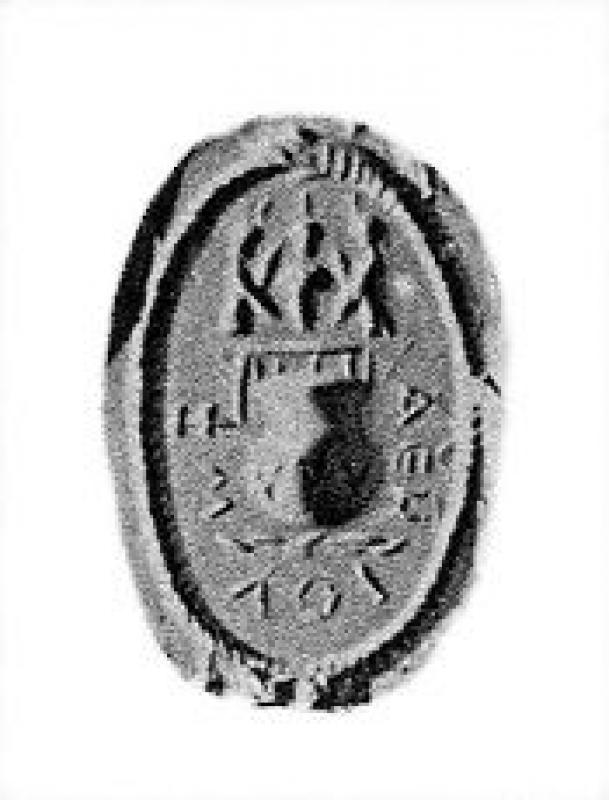 Bonner, SMA – PDF, 88.
Bonner, SMA – PDF, 88.
gathered in at the neck, and closely corresponding in shape to some of the uterine symbols previously treated; but this has its mouth upward, which is unusual.42 On each side of the vessel is a snake, its head approaching the lip of the vessel. Still higher on the stone is a disk with eight radii — whether a wheel or a conventionalized sun disk is uncertain. On the base of the altar Ιαω is inscribed, and below it in the exergue are the seven vowels. There is also an inscription encircling all but the lower third of the field, but apart from Σαβαωθ at the right it is unintelligible.
The greater part of the obverse side is covered with an inscription in what magicians called a pterygoma, that is in the form of a wing, made by repeating the first line, dropping the initial letter at each repetition, until only the final letter remains at the lowest point of the pattern. The words of the first line, which because of its length the engraver had to finish in the space above, are διψὰς Τάνταλε αἷμα πίε. The word διψάς, not found in earlier literature, is a feminine adjective; but doubtless by association with ἔχιδνα it came to be used as a substantive, a name for a kind of viper. This reptile's bite was believed to cause intolerable thirst, and, according to popular belief, it was the reptile's own thirst, imparted through its fangs, which tortured its victim. There was a folk tale that explained how the dipsas came to suffer from eternal thirst.43 The inscription, as its editor observed, is a puerile charm; but, dissenting from his interpretation, I take it to be an injunction addressed to the thirst-snake, “Drink up the blood”; and the uterine symbol on the reverse with a snake on each side shows that the whole amulet is intended for the cure of menorrhagia. The use of the vocative Τάνταλε addressed to the snake is very strange, but it must imply “thirsty as Tantalus”; “thirst-snake, a Tantalus for thirst,” or the like.44 It is only a curious coincidence that Lucian (De dipsadibus 6) says he had heard of a tomb stele for a man killed by the bite of a dipsas, and on it the sufferer was represented as artists represent Tantalus, standing in a pool and dipping up water, while some women hurry towards him and pour jars of water over him.
At the lower left of the obverse, in the space left by the diminishing pterygoma, there is a warrior standing to front, with his head turned to left. He wears a helmet and kilt, his right hand holds his spear upright, the left rests on the rim of his shield, which is just behind him. Over his head is a stylized thunderbolt. It does not seem possible to connect this warlike figure with the Tantalus of the myth, and I should call it Ares. We have already seen how such divine or heroic figures as Ares, Perseus, and Herakles were used in magic because they were formidable enough to drive away pain and disease;
42 But not unique; compare the interesting stone in the Fouquet collection (Barry, Ann. du serv., 7, Pl. 1 (opposite p. 288), A). A specimen in my collection, not otherwise remarkable, has the object in the same position (D. 135).
43 The principal source is Nicander Ther. 334–358, with the scholia. Aelian N.A. 6, 51, and Lucian De dipsadibus 4 ff., doubtless draw from Nicander.
44 I cannot accept Seyrig's rendering, “Tantale assoiffé bois le sang,” because I do not see how διψάς, as a feminine adjective, can be taken with Tantalus. Others, however, may find a difficulty in my assumption that Τάνταλος can stand in descriptive apposition with διψάς as the dominant substantive.
Cf. Dasen 2019, comm. ad Bonner, SMA 79–94
